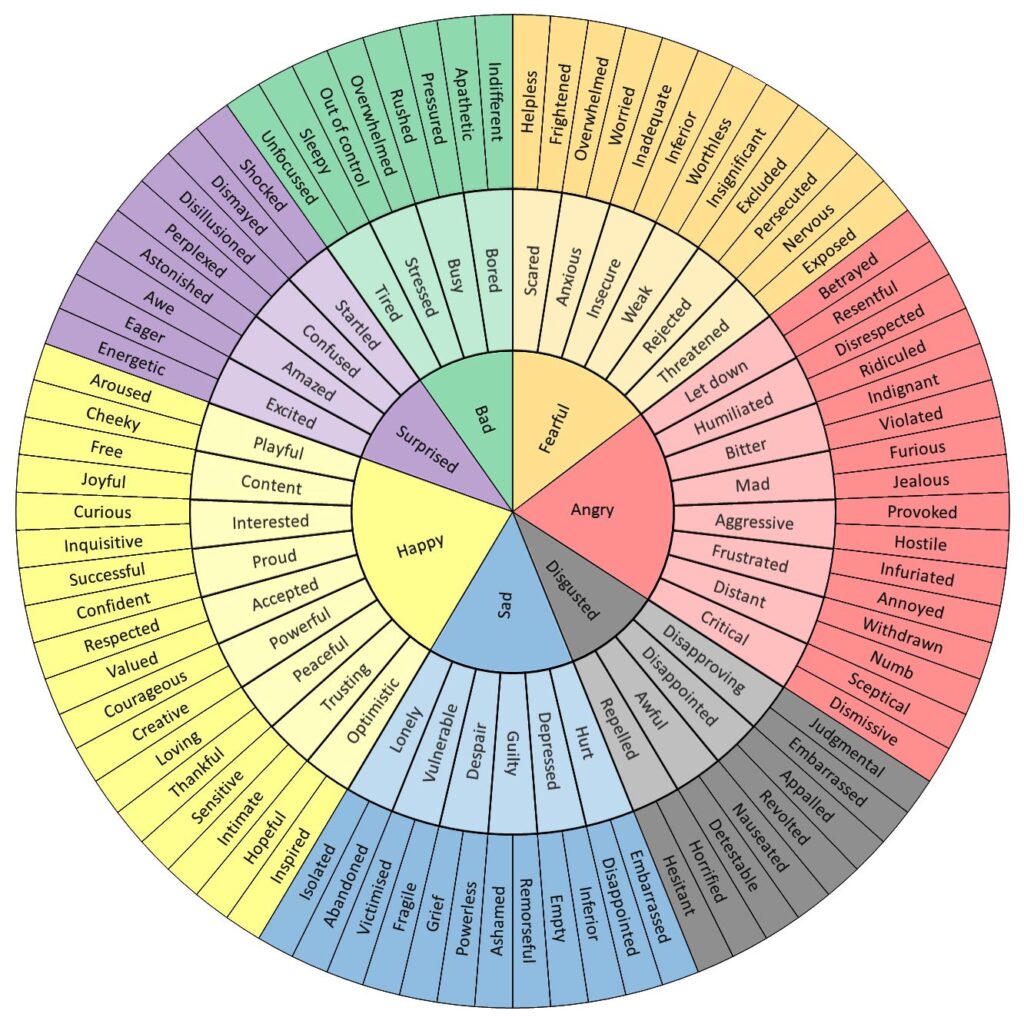Liberating yourself, in the ways you can, from injustice, past challenges, and unhealthy situations, is a key part of your soul care journey. To help yourself form daily habits that support your holistic mental health, grab a notebook, tablet, or other support tool to write about your experiences, needs, goals, and learning moments as you create your soul care toolbox.
Here are two tools you can develop, refine, and use to create the balance necessary for mindful justice that supports your emotional well-being and mental health.
1. Emotional Literacy: Understand What You’re Feeling
Striving to increase your emotional literacy is a well-being practice that you can use in your daily life to navigate moments of emotional intensity with confidence. Emotional literacy is a skill you can develop over time to support your emotional awareness. All this means is that you begin to understand what you are feeling.
As a young person of color in the United States, just existing can be a multifaceted experience with complex emotions and varied, sometimes limited, opportunities to fully articulate and express them. The feelings wheel below is a great resource you can use to enhance your emotional awareness. It can also help you seek the support and resources you may need to respond to your emotional state.
As you recognize injustice and, at times, prepare for action in small and large ways, this tool allows you to identify and describe your emotions, validate your experience, and understand what is happening within your mind and body.
Get Started!
- Assess Your Current Skill Set: Reflect on a recent intense emotional experience. Did you notice yourself taking a pause to name the emotions coming up for you? If you answered yes, during the pause did you have an easy time naming the emotions or did you find yourself struggling to articulate your experience? If you answered no, what was your first reaction to this emotional experience? Was this reaction useful to you or harmful to you? Use these answers to determine how much or how little practice you may need for this part of your toolbox.
- Get to Know the Feelings Wheel: Spend some time learning the structure and contents of the feelings wheel. Then, take a few minutes daily to practice using the feelings wheel to identify larger categories of emotions and then more specific descriptions of your emotional state. As you become more familiar with each category, it will become easier to narrow down the feelings you are experiencing in a given moment. As you strengthen your skills identifying a specific emotional state, you will develop a stronger foundation of emotional literacy to draw upon in your well-being practices.
- Remember to Locate Feelings in Your Body: As you set aside specific moments throughout your day to pause and check in with your emotions using the feeling wheel, remember to also zoom in on how your body is reacting to these emotions—notice any physical sensations, tension, or relaxation as you find words to describe your experience. Your body and its sensations can sometimes explain more about your emotional state than words can, especially during intense emotional experiences. Pay close attention to what areas are affected and use this information to select a practice for self-caretaking.
Learn How to Label Your Feelings. Use the Feelings Wheel to find appropriate labels for whatever you are experiencing. Label your emotions to feel less reactive and more in control of your feelings. Source: https://imgur.com/tCWChf6
2. Radical Acceptance: Let Yourself Accept Your Self
Radical acceptance involves acknowledging and accepting the reality of who you are or what a situation is without judgment or resistance. This practice helps reduce emotional suffering by allowing you to focus on what you can control and letting go of the struggle against what you cannot change.
In communities of color through history, this ability to accept ourselves has supported the emotional resilience of our ancestors through many generations. Embracing radical acceptance fosters inner peace and resilience, essential for navigating life’s challenges and sustaining your advocacy, activism and well-being efforts.
Like muscles in your body and neural pathways in your mind, gaining skills in this area is developed with time and intention. As you strengthen your ability to acknowledge and accept your reality for what it is, you will notice that you are able to move through adversity with more confidence and an empowered sense of self.
Get Started!
- Affirm your existence: Use affirmations that reinforce acceptance, such as “I accept this moment as it is” or “I am at peace with what I cannot change.”
- Let go: Practice visualizing the release of resistance and control over the situation, allowing yourself to feel lighter and more at ease.
- Practice gratitude: Focus on aspects of the situation or your life that you are grateful for, shifting your perspective to include positive moments or experiences in daily life.
- Be compassionate to yourself: Be kind to yourself and acknowledge that it’s okay to feel uncomfortable emotions without “fixing” them immediately.
- Practice acceptance statements: Write down statements that reflect your acceptance of the situation, such as, “This is the way it is right now,” or “I can handle this for now.”
Keep a journal dedicated to your practice of radical acceptance.
Write about situations that challenge you, your thoughts and feelings about these situations, and your efforts to accept them without judgment. Reflect on how practicing radical acceptance influences your emotional state and overall well-being. Document your progress and insights to reinforce the benefits of acceptance and to build a deeper understanding of how this practice can enhance your resilience and peace of mind. Share your journey towards radical acceptance with someone you trust and seek advice when needed on areas of growth.
Feelings Wheel sources: https://imgur.com/tCWChf6
Feelings Wheel – Geoffrey Roberts
Torre, J. B., & Lieberman, M. D. (2018). Putting Feelings Into Words: Affect Labeling as Implicit Emotion Regulation. Emotion Review, 10(2), 116-124. doi:10.1177/1754073917742706


